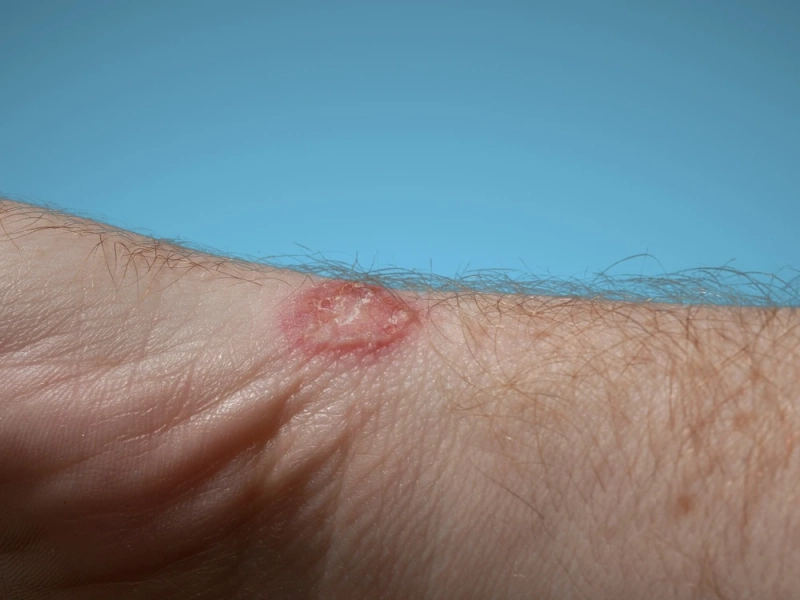Introduction
Have you ever noticed a round, red rash on your skin and wondered if it was an infection or just dry skin acting up? Many people confuse nummular eczema and ringworm because of their similar appearance. However, these conditions are quite different in terms of causes, symptoms, and treatments.
In this blog, we’ll break down the key differences between Nummular Eczema and Ringworm. You’ll learn how to spot the symptoms, get the right treatment, and prevent future flare-ups. By the end, you’ll have a clearer understanding of which condition you might be dealing with and how to manage it effectively.
What Is Nummular Eczema?
Nummular eczema, also called discoid eczema, is a chronic skin condition that causes coin-shaped patches of inflamed, itchy skin. Unlike ringworm, it is not caused by an infection but rather by a combination of environmental and genetic factors.
Common Causes and Triggers:
- Dry skin – Lack of moisture makes the skin more prone to irritation.
- Allergens – Certain fabrics, soaps, or metals can trigger flare-ups.
- Cold weather – Low humidity can worsen symptoms.
- Skin injuries – Cuts, burns, or insect bites may lead to flare-ups.
- Stress – Emotional stress can aggravate the condition.
Who Is at Risk?
Nummular eczema can affect anyone, but it’s more common in adults over 50 and people with a history of atopic dermatitis or allergies.
What Is Ringworm?
Despite its name, ringworm is not caused by a worm. It’s a fungal infection that leads to a characteristic red, ring-shaped rash with a clear center. The fungus responsible for this infection thrives in warm, moist environments.
How Does It Spread?
- Direct skin contact – Touching an infected person or animal.
- Contaminated objects – Shared towels, clothing, or gym equipment.
- Damp environments – Public showers, pools, and locker rooms increase the risk.
- Weakened immune system – People with diabetes or other conditions are more susceptible.
Who Is at Risk?
Ringworms can affect anyone, but it’s more common in children, athletes, and people with pets.
Symptoms: How Can You Tell Them Apart?
Both conditions cause itchy, red rashes, but there are some clear differences.
Key Differences in Symptoms
- Does the rash have a clear border?
- Yes? Likely ringworm – It forms a distinct, scaly ring.
- No? Likely nummular eczema – It appears as scattered, inflamed patches.
- Is the rash blistered or cracked?
- Blisters and oozing? Likely nummular eczema.
- Flaky, scaly skin? Likely ringworm.
- Where does the rash usually appear?
- Nummular eczema – Common on the arms, legs, and torso.
- Ringworm – Can appear anywhere, including the scalp, feet, and groin.
If you’re still unsure, consult a dermatologist for a proper diagnosis.
Diagnosis: When to See a Doctor?
Misdiagnosing these conditions can lead to ineffective treatment, so a doctor’s evaluation is crucial.
How Doctors Diagnose Nummular Eczema and Ringworm
- Physical Examination – A dermatologist examines the rash's shape, texture, and location.
- Skin Scrapings – For suspected ringworms, a sample is tested for fungal infection.
- Medical History – A family history of eczema or previous fungal infections can provide clues.
If over-the-counter treatments don’t work within a few weeks, schedule a doctor’s appointment.
Treatment Options: How Are They Managed?
Getting the right treatment is essential for relief. Since these conditions have different causes, they require different approaches.
Nummular Eczema Treatment
- Moisturizers – Hydrating creams reduce dryness and irritation.
- Topical Steroids – Helps reduce redness and inflammation.
- Avoiding Triggers – Switching to fragrance-free soaps and using a humidifier can help.
- Light Therapy – For severe cases, UV therapy may be recommended.
Ringworm Treatment
- Antifungal Creams – Over-the-counter creams like clotrimazole or terbinafine usually clear up mild cases.
- Oral Medications – For severe or widespread infections, prescription antifungal pills are needed.
- Keeping the Area Dry – Fungus thrives in moisture, so dry the area thoroughly after washing.
- Disinfecting Personal Items – Washing towels, clothes, and bedding prevents reinfection.
Prevention: Can You Stop Them From Coming Back?
While these conditions can be managed, taking preventive measures can reduce flare-ups and infections.
Preventing Nummular Eczema
- Apply moisturizer daily to keep the skin hydrated.
- Avoid harsh soaps and detergents.
- Wear loose, breathable clothing to prevent irritation.
- Manage stress, as it can trigger flare-ups.
Preventing Ringworm
- Don’t share personal items like towels, combs, or clothing.
- Wear sandals in public showers and locker rooms.
- Keep skin dry, especially in warm climates.
- Regularly bathe pets and check them for signs of infection.
Conclusion
While nummular eczema and ringworm can look similar, their causes and treatments are entirely different. Here’s a quick recap:
- Nummular eczema is a chronic skin condition triggered by dryness, allergens, and environmental factors.
- Ringworm is a contagious fungal infection that spreads through contact.
- The right diagnosis is key—eczema requires moisturizers and anti-inflammatory creams, while ringworm needs antifungal treatments.
- Prevention matters—hydrating the skin can help with eczema, while good hygiene can stop ringworm.
If you’re struggling with persistent or unclear skin issues, consult a dermatologist for proper guidance. For those dealing with eczema, ongoing research, and atopic dermatitis clinical trials may offer new treatment options.
Ready to take the next step? Protect your skin by following these prevention tips, and don’t hesitate to seek medical advice for a stubborn rash!


